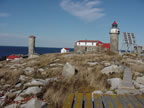
Matinicus Rock
This 28-acre island lies in outer Penobscot Bay, in the Town of Matinicus Isle Plantation. The Refuge acquired the island in 1999, under the Coast Guard Authorization Act of 1996. The island is dominated with granite out-croppings interspersed with vegetation. Dominant vegetation includes witch grass, timothy, angelica, aster, red fescue, and chickweed. The east side of the island is steep and rocky with large boulders that plunge into the sea. The west side of the island tapers off gradually and contains a gravel beach. Its habitats include approximately 10 acres of grassland and 18 acres of rock ledge. The Service is responsible for the light house structures, however the Coast Guard continues to maintain the navigational aids.
Matinicus Rock was the only Atlantic puffin colony (two pairs) within Maine to have survived the market hunting that decimated most seabird colonies in the late 1800’s and early 1900’s. Since 1900, the island has been a principal breeding site for Arctic terns on the Maine coast. It continues to be a highly diverse and productive seabird colony. Common and Arctic tern, laughing gulls, Leach’s storm-petrels, common eiders, Atlantic puffins, razorbills, and black guillemots nest on Matinicus Rock. Terns numbers had declined in the 1990’s, presumably due to the rapid growth of the nearby Seal Island tern colony. However, in recent years the colony has increased to 1,200 pairs of terns. Matinicus Rock remains home to the largest Atlantic puffin and razorbill colony in Maine.
The laughing gull population continues to increase, and now supports 624 pairs. The most recent alcid survey found over 300 puffin burrows, and 168 razorbill burrows. The island is predominantly an Arctic tern colony (999 pairs), but also supports 198 pairs of common terns. Small numbers of roseate terns have nested on the island, but not in recent years. Common murres continue to visit the social attraction area, but have yet to nest on the island. Table 3-20 presents the nesting seabirds known on the island.
We manage the island in cooperation with National Audubon Society. Biological technicians staff the island, conduct biological surveys (food and productivity studies), annually census the island, control predators, and band terns. We are participating in Arctic tern and Atlantic puffin research projects in cooperation with the University of New Brunswick. Annual survey and study results are available upon request from the Refuge Complex Headquarters.
The island also supports a wide variety of migrating songbirds, shorebirds and raptors, and island researchers continue to document the use of the island by these species.
